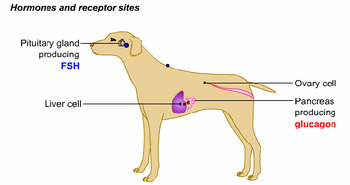No edit summary |
No edit summary |
||
| Line 1: | Line 1: | ||
[[Image:Endo.PNG|350px|right|thumb|Part of the endocrine system of a female dog.]] |
[[Image:Endo.PNG|350px|right|thumb|Part of the endocrine system of a female dog.]] |
||
| − | A common health problem experienced by between 2-7% of all women during pregnancy. The [[transient diabetes]] state ends shortly after giving birth<ref>{{cite web|url=http://www.babycenter.com/refcap/pregnancy/pregcomplications/2058.html |title=Gestational Diabetes in Humans|publisher=Babycenter.com}}</ref><ref>{{cite web|url=http://www.intelihealth.com/IH/ihtIH/WSIHW000/24479/2343/346096.html?d=dmtHealthAZ |title=Diabetes Overview|publisher=InteliHealth}}</ref>. Most women revert to non-diabetic status, but remain at higher risk for developing permanent diabetes than those who have never had gestational diabetes. |
+ | A common health problem experienced by between 2-7% of all women during pregnancy. The [[transient diabetes]] state ends shortly after giving birth <ref>{{cite web|url=http://www.babycenter.com/refcap/pregnancy/pregcomplications/2058.html |title=Gestational Diabetes in Humans|publisher=Babycenter.com}}</ref><ref>{{cite web|url=http://www.intelihealth.com/IH/ihtIH/WSIHW000/24479/2343/346096.html?d=dmtHealthAZ |title=Diabetes Overview|publisher=InteliHealth}}</ref>. Most women revert to non-diabetic status, but remain at higher risk for developing permanent diabetes than those who have never had gestational diabetes. |
| − | Animals are subject to this condition as well, with the same possibilites of returning to non-diabetic status after giving birth<ref>{{cite web|url=http://images1.wikia.nocookie.net/diabetesindogs/images/3/33/82_103335_caninsulin_au_binaries.pdf |title=Gestational or Transient Diabetes in Animals|publisher=Intervet}}</ref><ref>{{cite web|url=http://veterinarymedicine.dvm360.com/vetmed/article/articleDetail.jsp?id=456192&pageID=1&sk=&date= |title=Latest Management Recommendations for Cats and Dogs with Nonketotic Diabetes Mellitus|author=Cook, Audrey|year=2007|publisher=DVM 360}}</ref>. |
+ | Animals are subject to this condition as well, with the same possibilites of returning to non-diabetic status after giving birth <ref>{{cite web|url=http://images1.wikia.nocookie.net/diabetesindogs/images/3/33/82_103335_caninsulin_au_binaries.pdf |title=Gestational or Transient Diabetes in Animals|publisher=Intervet}}</ref><ref>{{cite web|url=http://veterinarymedicine.dvm360.com/vetmed/article/articleDetail.jsp?id=456192&pageID=1&sk=&date= |title=Latest Management Recommendations for Cats and Dogs with Nonketotic Diabetes Mellitus|author=Cook, Audrey|year=2007|publisher=DVM 360}}</ref>. |
See also: [[Secondary diabetes]], [[Causes]], [[Regulation difficulties]], [[Transient diabetes]] [[Image:I16.gif]] |
See also: [[Secondary diabetes]], [[Causes]], [[Regulation difficulties]], [[Transient diabetes]] [[Image:I16.gif]] |
||
Revision as of 02:49, 4 October 2010

Part of the endocrine system of a female dog.
A common health problem experienced by between 2-7% of all women during pregnancy. The transient diabetes state ends shortly after giving birth [1][2]. Most women revert to non-diabetic status, but remain at higher risk for developing permanent diabetes than those who have never had gestational diabetes.
Animals are subject to this condition as well, with the same possibilites of returning to non-diabetic status after giving birth [3][4].
See also: Secondary diabetes, Causes, Regulation difficulties, Transient diabetes ![]()
References
- ↑ Gestational Diabetes in Humans. Babycenter.com.
- ↑ Diabetes Overview. InteliHealth.
- ↑ Gestational or Transient Diabetes in Animals. Intervet.
- ↑ Cook, Audrey (2007). Latest Management Recommendations for Cats and Dogs with Nonketotic Diabetes Mellitus. DVM 360.
More Information
- Pregnancy-related diabetes mellitus in two dogs New Zealand Veterinary Journal 2006
- Gestational diabetes mellitus in 13 dogs Journal of Veterinary Internal Medicine 2008
- Canine and Feline Diabetes Mellitus: Nature or Nurture?-Diestrus-and gestation-associated diabetes Rand, Fleeman, et. al.-Waltham International Science Symposium 2004